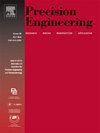Combining laser texturing and remelting for reducing friction and corrosive wear in Ti-based amorphous alloys
IF 3.5
2区 工程技术
Q2 ENGINEERING, MANUFACTURING
Precision Engineering-Journal of the International Societies for Precision Engineering and Nanotechnology
Pub Date : 2025-02-04
DOI:10.1016/j.precisioneng.2025.02.001
引用次数: 0
Abstract
Ti-based amorphous alloys are known for their high strength, hardness, and excellent corrosion resistance, but generally limited tribological performance. To reduce the coefficient of friction (COF) and mitigate corrosive wear, laser surface texturing and remelting were applied. Three distinct groove textures were fabricated: an asymmetric double-depth groove (AG), a remelting-formed dense low-depth groove (DLDG), and a combination of both textures (DLDG + AG). The tribocorrosion behavior were evaluated using reciprocating sliding tests against a Si3N4 ball in a 3.5 % NaCl solution. The AG sample demonstrated a 21.5 % reduction in COF and a 27.4 % reduction in wear rate. Due to remelting-induced oxidation and partial crystallization, the DLDG sample increased the COF but significantly enhanced wear resistance, improving it by approximately 40.6 times. Furthermore, the DLDG + AG sample effectively combined the advantages of laser texturing and remelting, reducing the COF by 26.9 % and enhancing wear resistance by 15.5 times. Regarding the corrosion without sliding, the DLDG sample exhibited the best corrosion resistance, while the AG sample showed deteriorated corrosion resistance. However, the DLDG + AG sample demonstrated the best corrosion resistance under sliding conditions with about 96.6 % reduction in corrosion current density. In conclusion, the combination of laser surface texturing and remelting offers a promising strategy to improve the tribocorrosion performance of Ti-based amorphous alloys by simultaneously reducing COF, enhancing wear resistance, and improving corrosion resistance.

求助全文
约1分钟内获得全文
求助全文
来源期刊
CiteScore
7.40
自引率
5.60%
发文量
177
审稿时长
46 days
期刊介绍:
Precision Engineering - Journal of the International Societies for Precision Engineering and Nanotechnology is devoted to the multidisciplinary study and practice of high accuracy engineering, metrology, and manufacturing. The journal takes an integrated approach to all subjects related to research, design, manufacture, performance validation, and application of high precision machines, instruments, and components, including fundamental and applied research and development in manufacturing processes, fabrication technology, and advanced measurement science. The scope includes precision-engineered systems and supporting metrology over the full range of length scales, from atom-based nanotechnology and advanced lithographic technology to large-scale systems, including optical and radio telescopes and macrometrology.

 求助内容:
求助内容: 应助结果提醒方式:
应助结果提醒方式:


